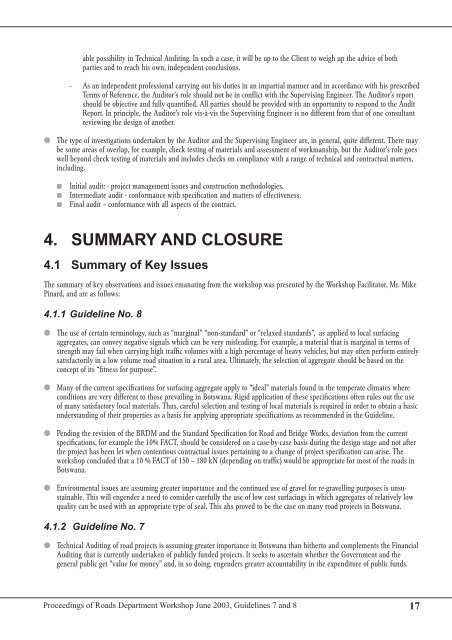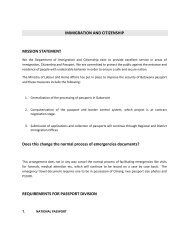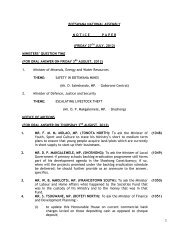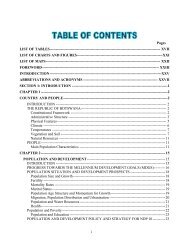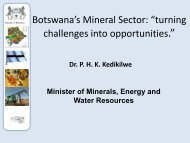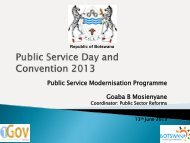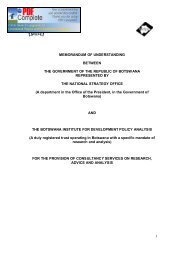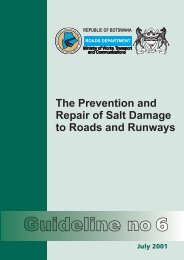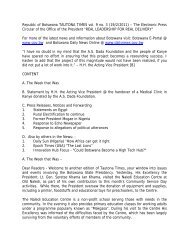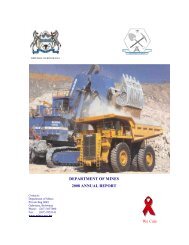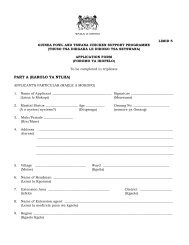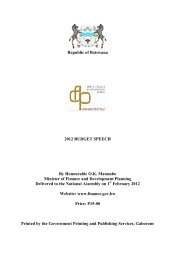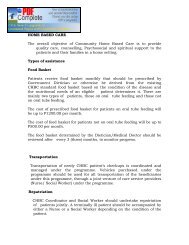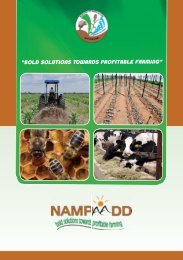7 and 8 - Government of Botswana
7 and 8 - Government of Botswana
7 and 8 - Government of Botswana
Create successful ePaper yourself
Turn your PDF publications into a flip-book with our unique Google optimized e-Paper software.
able possibility in Technical Auditing. In such a case, it will be up to the Client to weigh up the advice <strong>of</strong> both<br />
parties <strong>and</strong> to reach his own, independent conclusions.<br />
- As an independent pr<strong>of</strong>essional carrying out his duties in an impartial manner <strong>and</strong> in accordance with his prescribed<br />
Terms <strong>of</strong> Reference, the Auditor’s role should not be in confl ict with the Supervising Engineer. The Auditor’s report<br />
should be objective <strong>and</strong> fully quantifi ed. All parties should be provided with an opportunity to respond to the Audit<br />
Report. In principle, the Auditor’s role vis-à-vis the Supervising Engineer is no different from that <strong>of</strong> one consultant<br />
reviewing the design <strong>of</strong> another.<br />
● The type <strong>of</strong> investigations undertaken by the Auditor <strong>and</strong> the Supervising Engineer are, in general, quite different. There may<br />
be some areas <strong>of</strong> overlap, for example, check testing <strong>of</strong> materials <strong>and</strong> assessment <strong>of</strong> workmanship, but the Auditor’s role goes<br />
well beyond check testing <strong>of</strong> materials <strong>and</strong> includes checks on compliance with a range <strong>of</strong> technical <strong>and</strong> contractual matters,<br />
including.<br />
■ Initial audit: - project management issues <strong>and</strong> construction methodologies.<br />
■ Intermediate audit - conformance with specifi cation <strong>and</strong> matters <strong>of</strong> effectiveness.<br />
■ Final audit – conformance with all aspects <strong>of</strong> the contract.<br />
4. SUMMARY AND CLOSURE<br />
4.1 Summary <strong>of</strong> Key Issues<br />
The summary <strong>of</strong> key observations <strong>and</strong> issues emanating from the workshop was presented by the Workshop Facilitator, Mr. Mike<br />
Pinard, <strong>and</strong> are as follows:<br />
4.1.1 Guideline No. 8<br />
● The use <strong>of</strong> certain terminology, such as “marginal” “non-st<strong>and</strong>ard” or “relaxed st<strong>and</strong>ards”, as applied to local surfacing<br />
aggregates, can convey negative signals which can be very misleading. For example, a material that is marginal in terms <strong>of</strong><br />
strength may fail when carrying high traffi c volumes with a high percentage <strong>of</strong> heavy vehicles, but may <strong>of</strong>ten perform entirely<br />
satisfactorily in a low volume road situation in a rural area. Ultimately, the selection <strong>of</strong> aggregate should be based on the<br />
concept <strong>of</strong> its “fi tness for purpose”.<br />
● Many <strong>of</strong> the current specifi cations for surfacing aggregate apply to “ideal” materials found in the temperate climates where<br />
conditions are very different to those prevailing in <strong>Botswana</strong>. Rigid application <strong>of</strong> these specifi cations <strong>of</strong>ten rules out the use<br />
<strong>of</strong> many satisfactory local materials. Thus, careful selection <strong>and</strong> testing <strong>of</strong> local materials is required in order to obtain a basic<br />
underst<strong>and</strong>ing <strong>of</strong> their properties as a basis for applying appropriate specifi cations as recommended in the Guideline.<br />
● Pending the revision <strong>of</strong> the BRDM <strong>and</strong> the St<strong>and</strong>ard Specifi cation for Road <strong>and</strong> Bridge Works, deviation from the current<br />
specifi cations, for example the 10% FACT, should be considered on a case-by-case basis during the design stage <strong>and</strong> not after<br />
the project has been let when contentious contractual issues pertaining to a change <strong>of</strong> project specifi cation can arise. The<br />
workshop concluded that a 10 % FACT <strong>of</strong> 150 – 180 kN (depending on traffi c) would be appropriate for most <strong>of</strong> the roads in<br />
<strong>Botswana</strong>.<br />
● Environmental issues are assuming greater importance <strong>and</strong> the continued use <strong>of</strong> gravel for re-gravelling purposes is unsu-<br />
stainable. This will engender a need to consider carefully the use <strong>of</strong> low cost surfacings in which aggregates <strong>of</strong> relatively low<br />
quality can be used with an appropriate type <strong>of</strong> seal. This ahs proved to be the case on many road projects in <strong>Botswana</strong>.<br />
4.1.2 Guideline No. 7<br />
● Technical Auditing <strong>of</strong> road projects is assuming greater importance in <strong>Botswana</strong> than hitherto <strong>and</strong> complements the Financial<br />
Auditing that is currently undertaken <strong>of</strong> publicly funded projects. It seeks to ascertain whether the <strong>Government</strong> <strong>and</strong> the<br />
general public get “value for money” <strong>and</strong>, in so doing, engenders greater accountability in the expenditure <strong>of</strong> public funds.<br />
Proceedings <strong>of</strong> Roads Department Workshop June 2003, Guidelines 7 <strong>and</strong> 8 17


